Puffed LiPo Batteries
Can You Still Use Them?
by John Salt - Last Updated July 2025
I really got an appreciation of how strong a LiPo battery cell is when LiPo puffing occurs.
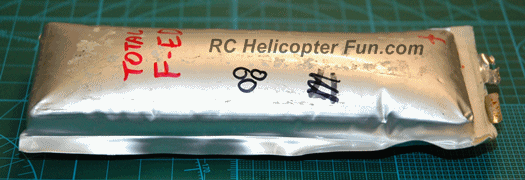 Puffed LiPo Cell
Puffed LiPo CellThe above picture shows a 5000 mAh cell that had shorted internally during a flight. This one cell experienced thermal runaway, completely puffed out and got very hot! Too hot to touch in fact, and I was sure the entire LiPo pack was going to blow after I landed.
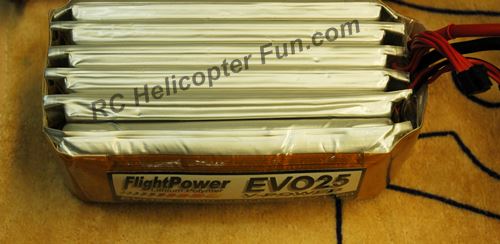 Puffed/Swolen LiPo Cell In 6S Battery Pack
Puffed/Swolen LiPo Cell In 6S Battery PackThat was not the case however and the plastic pouch cell contained all the vaporized electrolyte (process called gassing). It was tight as a drum mind you, but no venting or fire occurred.
What Causes LiPo Puffing?
As was just mentioned, a puffed LiPo cell is caused by gassing of the electrolyte. If you really want to impress your buddies out at the flying field or race track, tell them this process is called "electrolyte decomposition."
Electrolyte decomposition is the chemical breakdown of the electrolyte into its primary elements, mostly lithium and oxygen (lithium oxide - Li2O).
This compound will be deposited on the anodes or cathodes of the cell (depending if you are over charging or over discharging). The puffing happens when excess oxygen in this reaction is also released. Another reason why LiPo's are even more flammable during/after puffing - they can contain a fair amount of oxygen.
A good number of other elements & compounds are also released as the electrolyte decomposes such as CO2, but the main ones we should know about are Li2O with excess O2. If you want a deeper understanding of the chemistry involved in this complex process, here's a good article.
But what causes this electrolyte gassing in the first place?
I cover all the reasons why electrolyte gassing occurs and how to avoid it on my LiPo Battery Usage & Care page, but for most newbies, the number one reason a LiPo puffs up is OVER DISCHARGING your LiPo packs.
Again, I can't stress enough how damaging over discharging is to any LiPo battery. The golden rule is you should NEVER EVER drain a LiPo pack below 80% of it's capacity, or about 3.4V per cell under load (3.74V unloaded).
There are certainly other reasons for LiPo off gassing which are covered in detail on that LiPo page, but by far the most common is over-discharging.
If you are flying or driving any LiPo powered RC model to the point you notice or hear it's slowing down or LVP (low voltage protection) is activated, you have already started to damage the LiPo pack. The more current you are pulling at this point, the more the pack will heat up and the more it will start puffing up.
If you over discharge / abuse your LiPo pack this much, even once, on a large or powerful RC model that is pulling lots of current, the LiPo pack will get very hot and likely be destroyed by excessive electrolyte decomposition / gassing. That's an expensive flight or drive and lesson learned the hard way.
Is it normal to experience swollen or puffed LiPo packs when they are not abused? Can I still use a LiPo that is puffed?
As we just found out, LiPo cells can & will swell. Even if they are never abused by over discharging or other avoidable abuse, it's actually somewhat normal as they age since slight electrolyte decomposition is occurring all the time. LiPo's are consumable items in this hobby.
The speed at which it occurs, and if excess O2 or CO2 is released, is based on many factors including how hard you run (discharge) the packs, how fast you charge them, how you store them, their age, the quality of the packs, and of course how much they heat up during use.
A LiPo battery / cell can therefore puff during a single abusive use or puff very slowly over many months/years of normal usage. They can also slowly puff while sitting unused in a fully discharged or charged state for many months.
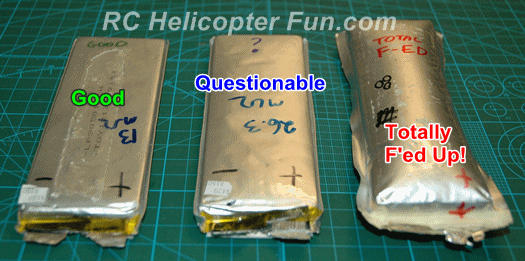 Levels of LiPo puffing from none on the left, to drum tight on the right.
Levels of LiPo puffing from none on the left, to drum tight on the right.As long as it is very minor LiPo puffing and goes away after the pack cools down, it has been my experience that you can usually still safely use the pack and keep the swelling in check; not to its full discharge potential however.
As one of Richard Burton's classic lines from the movie Who's Afraid of Virginia Woolf said "The puff went away..." One could even say LiPo puffing is "an inevitability". :)
This doesn't apply to puffed LiPo packs that have sat in storage fully charged or discharged as their puffing is also associated with catastrophic anode/cathode oxidation & electrolyte decomposition. It has been my experience over the past couple decades that LiPo's that puffed up while in storage for long periods of time were all 100% useless afterward.
Remember in the LiPo write-up where I mentioned the importance of having the internals of the LiPo cell (anode, cathode, & polymer separator), all pressed and held tightly together for maximum ion exchange, which in turn provides the lowest possible LiPo internal resistance. What do think happens when the cell puffs up slightly?
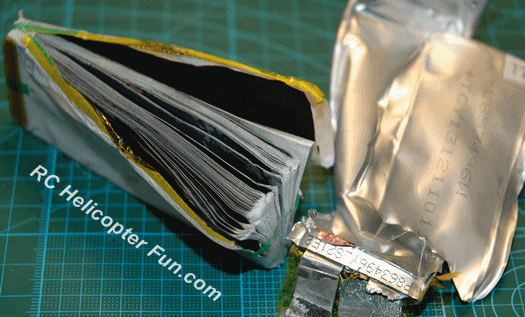 LiPo Battery Ion Efficiency & Low Internal Resistance Requires The Many Anode & Cathode Layers To Be Firmly Pressed Against The Polymer Separator Film
LiPo Battery Ion Efficiency & Low Internal Resistance Requires The Many Anode & Cathode Layers To Be Firmly Pressed Against The Polymer Separator FilmYep, that strong "pressed" lamination bond between all those layers, can be compromised, not to mention the electrolyte has partially broken down. Which in turn increases the internal resistance, which creates more heat while used, which creates even more puffing and can lead to good old thermal runaway!
Every "puffing" incident will be different depending on how much LiO2 & excess O2 has formed, and how much internal delamination between layers occurs.
If the internal resistance of a swollen cell is significantly higher than the other/s in the pack, that would be a damn good indicator too much Li2O has formed on the anode/cathode, and/or the bond between layers has weakened too much, and good reason to stop using that pack right away.
If however the internal resistance has not increased much with that slightly puffed cell, then it's still likely okay to use with relative safely, if you are careful.
As packs age, the swelling can and usually will get worse. It's basically a positive feedback loop. The initial puffing incident causes the resistance to increase, causing the packs to run hotter, increasing gassing, making the puffing & delamination worse, decreasing ion exchange efficiency, increasing resistance even more.
As a LiPo pack/cell is nearing the end of it's useful life it can show some very minor swelling that won't go away, even after the pack cools. This pack may still have some nice non aggressive flights or drives left in it, or it could be a ticking time bomb that is primed for a thermal runaway event!
Some feel once a LiPo battery is showing any swelling whatsoever that won't go away, they are not safe to use and must be disposed of.
My own experience over the past 17 years is as long as the internal resistances between slightly puffed & non puffed cells remain fairly equal, they all still balance up fine during the charge cycle, and they all still accept most of their charge capacity; as long as you treat them kindly with gentler flying/driving, you can generally get more safe cycles out of them.
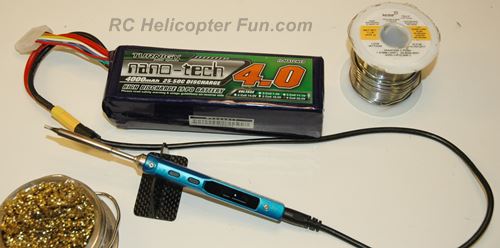 This tired & slightly puffed LiPo works perfectly fine in low current applications. However, I certainly wouldn't use or trust in a heli anymore!
This tired & slightly puffed LiPo works perfectly fine in low current applications. However, I certainly wouldn't use or trust in a heli anymore!I also often repurpose these slightly puffed, tired packs for powering low demand items that don't draw much current.
Hobby soldering iron for example, LED or electronic bench projects.
Still, we are doing so at are own risk!
When in doubt, send permanently puffed LiPo packs/cells to the LiPo *grave yard (once fully discharged).
*Check your local city office, waste disposal service, recycling facility/s or where you purchased your LiPo from for LiPo battery recycling / disposal options in your area.
Puffed Lipo Fixes
Despite what you may have read or seen others do on the good old interweb, there is no safe or realistic way to vent or "de-puff" a swollen LiPo cell or battery and expect it to last or function afterward.
Regardless of the electrolyte decomposition, excess build up of Li2O, possible delamination, and decreased ion exchange efficiency which have all occurred; if you poke a tiny hole through the cell to vent the O2, you have just introduced another problem - air contamination. The LiPo manufacturing process is critical to a clean room environment and zero humidity. Water vapor, even in tiny amounts will quickly cause more unwanted reactions within the cell and produce even more off gassing.
I've tried to vent puffed LiPo cells numerous times, even in a clear plastic bag filled with inert argon welding gas during the process. I pressed the cell tight after it vented, and then sealed the tiny pin prick hole.
Internal resistance on every swollen cell I've tried this on increased very quickly afterward during the first use, and soon the cells were more swollen than before with off the chart internal resistance values.
All were useless and dangerous afterward! DON'T vent puffed cells!














